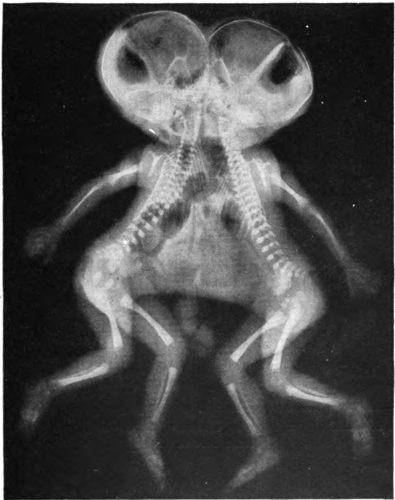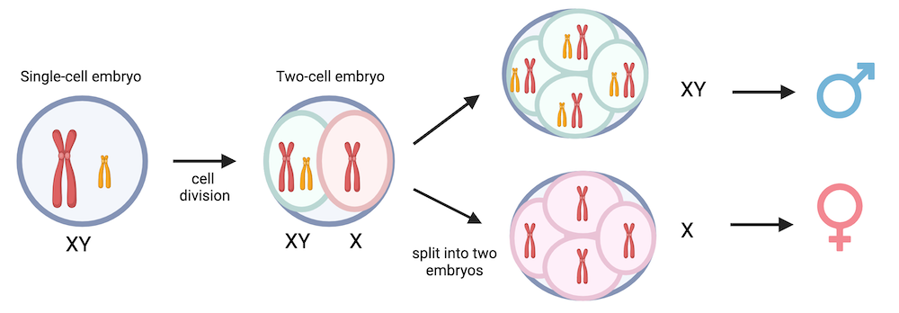
Is it possible for a conjoined twin pair to have two different genders?
March 5, 2024

- Related Topics:
- Twins,
- LGBTQ+,
- Developmental biology,
- Genetic sex,
- Gender identity,
- Editor's choice
A student from Nebraska asks:
I was wondering if it was possible for a conjoined twin pair to be two different genders (like a boy and a girl). I have always loved learning about things like this but have never been able to find anything out. I have been wondering about this for a while.
The short answer is yes!
Conjoined twins are a specific type of identical twin pair. They are formed when a single fertilized egg partially splits apart early in development.
Conjoined twins — and other identical twins — typically have the same DNA. But that doesn’t necessarily mean they’ll have the same gender!

Same DNA = Same gender? Not necessarily!
You maybe remember that most males have XY chromosomes while most females carry XX chromosomes. But what does that mean?
The X and Y are called sex chromosomes. They have a huge effect on a person’s physical development. A person with a Y chromosome will typically develop male anatomy. A person without a Y chromosome will typically develop female anatomy.
But sex and gender are not the same thing. Sex is determined by sexual characteristics such as our reproductive organs. Gender, on the other hand, includes the psychological, behavioral, and social aspects of being a man, woman, or other non-binary identities.
Gender identity is influenced by genetics as well as other factors such as hormones1. So although identical twins have the same DNA, they can identify as different genders.
There are actually many examples of identical twins who identify as different genders, such as Jonas and Nicole Maines. And there’s even an example of a pair of conjoined twins who have different gender identities.

Nicole Maines is an actress and transgender rights activist. She and her identical twin brother Jonas were assigned male at birth, but from an early age had different gender identities.
Lori and George Schappell
Lori and George were born in Pennsylvania in 1961, both assigned female at birth. They are joined by the forehead, which makes them craniopagus twins, an extremely rare condition that occurs roughly 1 in 2.5 million live births2.
Ever since their childhood, George felt a deep sense of unease about his gender, a sign of gender dysphoria. “I have known from a very young age that I should have been a boy,” he said during an interview with The Sun3. Later, he came out as a trans man, and his transition made them the world’s first known pair of conjoined twins identifying as different genders.
Despite being conjoined twins and identical in their DNA, Lori and George are known to have very different personalities and lived different lives. Lori is cheerful and warm while George is quiet and independent, according to a New York Times interview4.
Currently, George is working as an award-winning country singer performing around the country, while his twin sister Lori acts as his facilitator while working in a laundry. They have appeared in multiple documentaries and talk shows and have even acted in TV series.

Lori and George Schappel are conjoined twins with different personalities, interests, and gender identities. In this 1997 interview (which took place before George transitioned), they candidly discuss how they are able to live separate lives.
Could conjoined twins have different sexes?
Lori and George’s story demonstrates that conjoined twins with identical DNA can have drastically different personalities and identify as different genders. But it’s also theoretically possible for conjoined twins to be assigned different sexes at birth.
We typically think of identical twins as having identical DNA. And for the most part, that’s true. But there are some exceptions to this.
We all started as a single embryo, which divided again and again to form the trillions of cells in us. As our cells divide and copy their DNA, mistakes can happen during the copying process, leading to changes in our DNA.
If a mistake like that happens soon after an embryo splits into identical twins, the identical twins will be not-entirely-identical.
For example, identical twins differ by roughly 5 single-letter differences in their DNA on average5. Usually small changes don’t have an effect. But in rare cases, those genetic differences might contribute to some of the differences observed in the twin pair.
But it’s also possible for identical twins to have much larger genetic differences. Sometimes when cells divide, they lose (or gain) entire chromosomes. If a change like this happens after the embryo splits apart into twins, they will be born with different numbers of chromosomes.

While it’s extremely unusual, there have been several dozen examples like this of identical twins who were born different sexes6. This usually happens when a male embryo (with XY chromosomes) splits into twins, and then one twin loses the Y chromosome. In those cases, one twin will be born male (XY chromosomes) and the other will be born female (with a single X chromosome).
So far there haven’t been any documented examples of this happening in conjoined twins. Since they’re a type of identical twins, it’s theoretically possible. But it would be extremely rare!

Author: Lucy Zhang
When this answer was published in 2024, Lucy was a Ph.D. candidate in the Department of Genetics, studying the roles of immune cells during heart development and congenital heart disease. Lucy wrote this answer while participating in the Stanford at The Tech program.
 Skip Navigation
Skip Navigation
